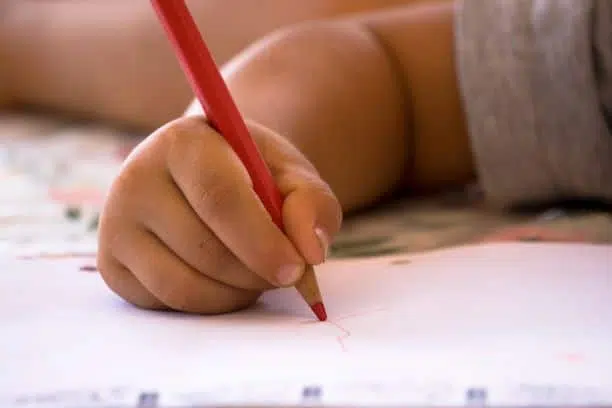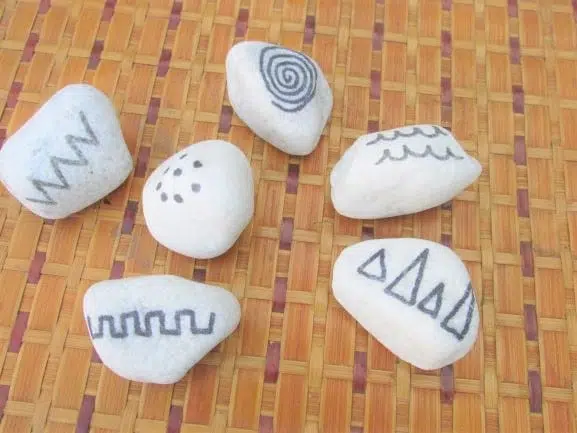Lots of teachers and parents wonder about which type of writing equipment is best for preschool-aged children. This is a unique stage of life, and therefore they should probably be using tools that are tailored for them. A common question is, should pre-schoolers use fat pencils?
Yes, pre-schoolers should use fat pencils. They will suit the level of muscle development in their hands much better than thin pencils. They will produce better results, and make the process of writing less stressful or painful.
That’s the short answer; however, there is a lot more to it than that. Before they even begin with fat pencils, children should use other mark-making tools. But such as what? How long should they use fat pencils? Why should they use them?
This article answers all your questions about children aged 3-5 using fat pencils, and more. I should say that in this article I am writing specifically about children aged 3-5. (I know that in some countries the word preschool means different things)

Why Children Aged 3-5 Should Use Fat Pencils
There are many reasons why larger pencils are definitely the way to go for younger children. These include:
1.Muscle Development
This is the big one. A child’s hand goes through a rapid amount of change between birth to at least the age of seven. There are lots of changes in the muscles, bones, and pretty much everything else.
Children are able to grip onto wider objects better than thin ones for a sustained time. Also larger pencils is easier to coordinate.
In general fine motor control develops more slowly than gross motor. To find out the other main 11 differences between fine and gross motor, then take a look at this article I wrote.
2.Doing Things On A Big Scale
Thinking big is good when children are starting to mark-make or write letters.
It is a great idea to use big surfaces such as wallpaper, the floor, or large chalkboards. Large writing tools are great for these big surfaces, so things like pens, big chalks, big pencils, and other similar tools are perfect.
Big tools and large surfaces allow for lots of gross motor movement and development, alongside the fine motor skills that children will be developing also.
3. Reducing Pain/Stress
Using thin pencils for younger children can quite simply be painful. They will say that their hand hurts, and why would anyone want to do something that causes them pain.
Using painful writing tools can put children off writing permanently, so definitely always go for the fat pencils.
What Comes Before Fat Pencils
Fat pencils are only really part of a spectrum. Children should start off with largescale mark-making equipment even before they move on to pencils. Some great things to start mark-making with include:
- Fingers! – These are great to draw with in substances like foam, mud, shaving gel, or gloop
- Sticks – These are excellent for mark-making in sand or mud. There are many different objects and loose parts that can be used for drawing and writing (check out some ideas amongst this article about the 40 greatest loose parts play activities).

- Big paintbrushes – They really enjoy using massive brushes and buckets of water to wash and paint things with outside. Great for pretending to wash cars, or ‘paint’ a fence or shed.
- Big chalks – The bigger the better! Great for mark-making on concrete outside, or on large surfaces that have been painted with chalkboard paint – for example, fences or tables.
- DIY writing tools – an example I saw of this recently were maracas covered in bubble wrap. The children dipped them in paint and then stamped them onto paper, where they made a beautiful spotted effect. Developing fine motor skills in fun and positive ways has a huge number of benefits for children.
Writing Activities Using Fat Pencils
When you are at the point when using fat pencils is the way to go, then there are certain types of activities you can try out to maximize the learning and the motivation children have.
Some good ideas include:
1.Mark-Making Lines
These are simple lines such as zig-zags, dots, circles, and other lines such as this. These are much simpler than writing letters.
Adult-led mark-making using these kinds of lines are a great way to get some structure into children’s mark-making. Good ideas are:
- Mark making to music
- Creating big-scale art with mark-making lines
- Making things like maps with symbols on
- Using stones or dice with mark-making lines on

2. Big Surface Mark-Making
Big surfaces are enticing and exciting for children to write on. All you need is large pieces of paper such as old wallpaper. Some good ideas include:
- Stick a piece of large paper across either the top of a table, or under the table. Pieces of paper stuck in strange places are great for encouraging children to mark-make
- Making maps – these could link to books, or could be treasure maps, or maps of children’s journeys they have taken
- Making huge characters on paper – like giants or baddies
3. Activities Based On interests
Whatever the children are interested in they are much more likely to write about. Delivering learning through interests is one of the key motivators to young children.
Try to work out what these interests are and devise activities based on them.
For example, a child interested in aliens could try some of the following:
- Drawing aliens with different numbers of heads etc
- Draw a star-map
- Give a picture of an alien a name
- Make up alliterative names for an alien
- Write a list of things to take to space
- Write a list of planets
4. Use Real Life Things To Write On
The more real you can make writing the better. For examples of things you could write on include:
- Envelopes. This might inspire them to write letters to characters, friends or family
- Postcards – Any old postcards you can find
- Christmas cards – Some children will spend hours mark-making on Christmas cards. Even if they are just using lines and circles, this experience is motivating and beneficial
- Cards for other festivals, e.g. Diwali
- Spell books – e.g. like a witches’ book that you can write all sorts of spooky concoctions in
- Diaries – anything with a bit of secrecy inspires curiosity in children
- Small notepads
- Paper on clipboards. This is great for moving around the room and using to mark-make in different contexts
- Post-it notes – they love creating messages and sticking them on different things
What Else Will Help The Process Of Writing With Fat Pencils?
Here are just a few helpful tips:
- Keep the pencils reasonably sharp
- You can stick things to the ends of the pencils like superhero’s faces
- Use other tools like stencils
- Combine use of pencils with other things like felt-tip pens
- Give them a range of exciting things to write on
When Are They Ready For Smaller Pencils?
There will come a point when children are ready to transition onto using thinner pencils. There are some indicators that might suggest when this will be, that include:
- When their writing has become more coordinated
- They are beginning to write on lines successfully
- They are able to write without tiredness or pain for a longish period, probably at least ten minutes
Thin pencils at this point will help their writing. It will make it smaller and neater looking.
Conclusion
Fat pencils are definitely the way to go instead of thin pencils, but they are only half the story. Encourage children to use a range of exciting mark-making tools and they will make progress much more quickly. The more you can entice them into the writing process the better.
READ MORE
How to teach a child to write their name – the complete guide
